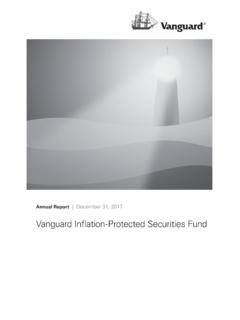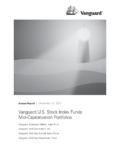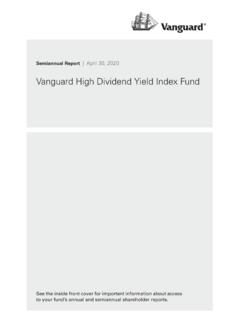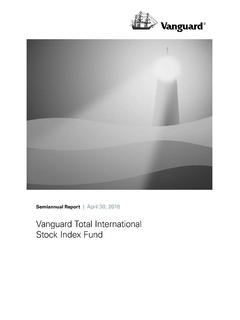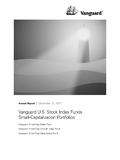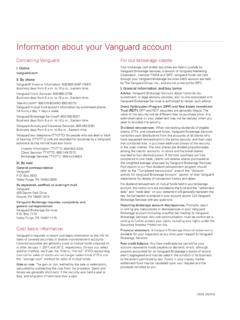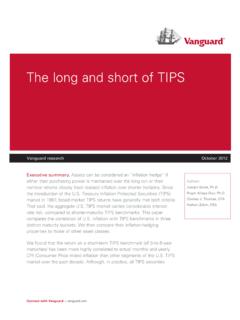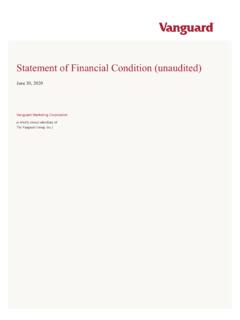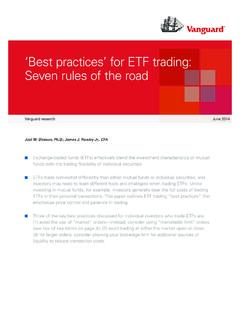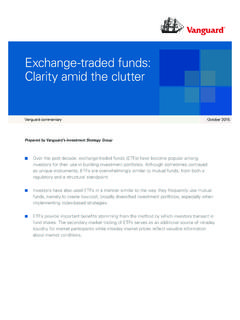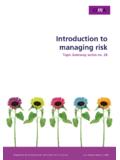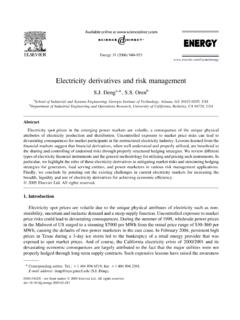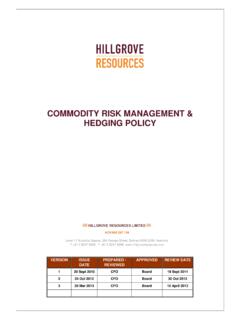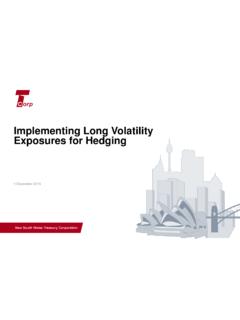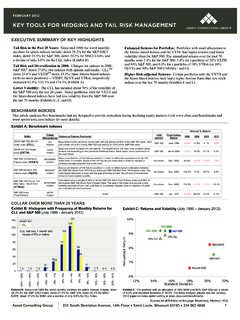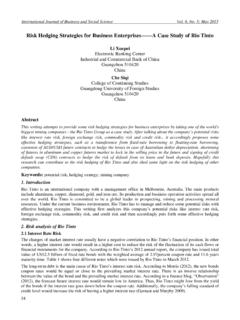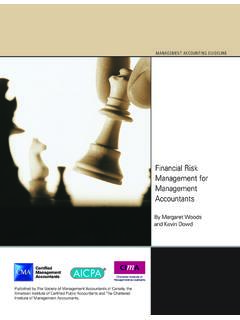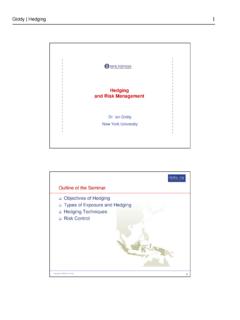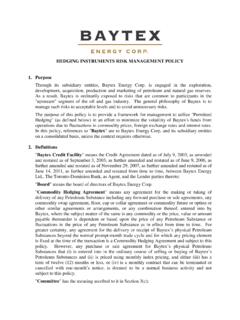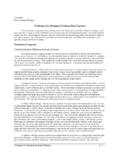Transcription of To hedge or not to hedge? Evaluating currency exposure in ...
1 Decreasing investor home bias (namely, overexposure to an investor s domestic market) has resulted in rising allocations to foreign assets and increased investor interest in managing foreign- currency exposure . A reasonable forward-looking assumption is for an unhedged and a hedged investment to produce similar gross returns over long time horizons. Therefore, we propose a framework for Evaluating currency exposure based on risk, not return, for investors willing to tolerate a modest return drag from hedging , evaluated using an ex ante (that is, before the event ) perspective. Since currency is typically more volatile than fixed income assets, we urge investors to consider fully hedging their portfolios fixed income allocation.
2 The case for hedging an equity portfolio is more nuanced, since hedging s impact on risk is a function of two key factors: the relative volatility of the asset versus that of the foreign currency , and the asset currency correlation. We argue that investors should consider hedging at least a portion of the foreign- currency exposure within their equity allocation, based on the following criteria: (1) availability of a low-cost hedging program or hedged equity product; (2) belief that the foreign currency is unlikely to be a diversifier in the investor s local market; (3) smaller domestic allocation, resulting in greater currency exposure ; (4) a portfolio objective specifically targeting Peterson LaBarge, , CFP ; Charles Thomas, CFA; Frank Polanco, , CFA; Todd Schlanger, CFAThe buck stops here: Vanguard money market fundsVanguard Research September 2014To hedge or not to hedge ?
3 Evaluating currency exposure in global equity portfoliosWhen investors buy foreign assets, they obtain exposure not only to the underlying securities but also to foreign currency , meaning that movements in exchange rates play a significant role in determining the performance of a foreign investment. Increasingly, investors are wondering whether to hedge1 this foreign- currency exposure . One reason driving this heightened interest is the fall in home bias, defined as an investor s overweighting to his or her home market relative to its share of the global market. For investors, home bias dropped 11 percentage points from 2001 through 2012. During the same time period, equity investors in the United Kingdom, Canada, and Australia reduced their home bias by 23, 10, and 14 percentage points, respectively (Philips, Kinniry, and Donaldson, 2012).
4 2 This smaller home bias, resulting from a larger foreign allocation, means a larger foreign- currency exposure . To provide context for investors who are examining their currency exposure , this paper analyzes relevant factors in deciding whether to hedge that exposure or to leave it can lead to different results for an identical investment Foreign- currency exchange rates are not static. The resulting impact of this volatility on unhedged portfolio returns can be significant. Figure 1 presents the annual performance of the developed global equity market denominated in various developed currencies over the ten years through 2013. The stronger the foreign currency and the weaker the home currency the more positive will be the impact on the return of a global equity portfolio when translated back into the investor s home success for a hedging program: Return production or risk reduction?
5 Foreign- currency exposure affects a portfolio s volatility as well as its long-term returns. A currency management strategy that seeks to maximize portfolio returns as its primary goal may be quite different from one that seeks to reduce overall portfolio But whatever the goal, the strategy should be consistently designed, implemented, and evaluated against the primary objective: return impact or risk reduction (Statman, 2005). To start with one objective and then evaluate the results against another is a self-defeating considering the hedging decision, some investors may distinguish between a strategic versus a tactical approach. Extensive research indicates that short-term currency movement is very volatile and extremely difficult to forecast accurately, diminishing the case for a short-term tactical approach to currency management (Solnik, 1974; Meese and Rogoff, 1983; Perold and Schulman, 1988).
6 Although some investors may choose to engage in an active, tactical approach to generate added return through 1 currency hedging is the process of reducing risk to fluctuations in foreign currency exchange rates, and is typically carried out using forward currency For further discussion of the recent trend of investors reducing the bias toward their own home market, see Philips et al. (2012).3 Investors have often directed their foreign equity investments into hedged or unhedged products based on the recent strength or weakness of the foreign currency . For example, during a period of yen strength, for the 12 months ended April 2010, 100% of net cash flows into Japanese-equity ETFs went into hedged vehicles, but only four years later, after a period of yen weakness (and relative dollar strength), investors who invested in Japanese-equity ETFs directed more than 97% of their cash flows into hedged on risk: All investing is subject to risk, including the possible loss of the money you invest.
7 Bond funds are subject to interest rate risk, which is the chance that bond prices overall will decline because of rising interest rates, and credit risk, which is the chance that a bond issuer will fail to pay interest and principal in a timely manner or that negative perceptions of the issuer s ability to make such payments will cause the price of that bond to decline. In a diversified portfolio, gains from some investments may help offset losses from others. However, diversification does not ensure a profit or protect against a loss. Past performance is no guarantee of future in stocks issued by companies are subject to risks that include country/regional risk, which is the chance that political upheaval, financial troubles, or natural disasters will adversely affect the value of securities issued by companies in foreign countries or regions; and currency risk, which is the chance that the value of a foreign investment, measured in dollars, will decrease because of unfavorable changes in currency exchange rates.
8 Stocks of companies based in emerging markets are subject to national and regional political and economic risks and to the risk of currency fluctuations. These risks are especially high in emerging One could argue for a dynamic, yet strategic, approach to currency management to capture the dynamic nature of currency -asset correlations. Although this is not our approach here, see Opie, Brown, and Dark (2012) for a discussion of dynamic currency hedging . 5 It is important to remember that a hedged investment is not merely one with the return impact of the exchange-rate change removed. There is also an interest rate differential that influences a hedged investor s return. For further details, see Thomas and Bosse (2014).6 Said another way, we believe the unbiasedness hypothesis is likely to hold over long time periods.
9 This hypothesis states that the forward exchange rate is an unbiased predictor of the future spot exchange rate (Levi, 2005). This expected equality follows from the fact that both the covered and uncovered versions of interest rate parity depend on the same interest rate differential. In other words, the market s expectation for currency movement is already embedded in the prices of forward contracts, which are used for hedging . For further discussion, see Chinn and Quayyum (2012).7 As Lothian and Wu (2011) pointed out, although uncovered interest rate parity (UIP) tends to hold over the very long haul, long periods of UIP deviation can occur due to slow adjustment after regime changes. This slow adjustment can be for actual and anticipated regime changes or other nonmaterializing trading, we do not consider that approach here.
10 Rather, in Evaluating the hedging decision, we focus on long-term, static, strategic Over the long term, for a currency management program to produce added return in strategic asset allocations, one must believe not only in a persistent return (positive or negative) from foreign currency , but also that this return will differ substantially from the return realized by hedging produces a return that reflects differences in interest rates across markets. Over the long term these interest rate differences adjust for underlying fundamental differences across markets, such as inflation levels. Arguably, long-term foreign- currency movement is driven by similar factors, even if it is much more volatile in the short-term. Therefore, with forward-looking financial markets, persistent arbitrage between a hedged and unhedged investment seems a difficult proposition over the long It is true that any ex-post (that is, after the fact ) outcome is 3 Figure 1.
